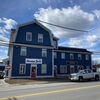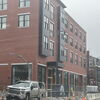Bangor's growing cultural offerings underscore its creative economy
It's a great problem to have: Do we head to the Cool Sounds concert and outdoor market in Pickering Square in downtown Bangor or over to the Pecha Kucha event at Nocturnem Draft Haus? Do we hit the downtown Bangor Arts Collaborative Art Walk or venture down to the Waterfront Concert on the banks of the Penobscot River?
In much the same spirit that we used to preserve downtown Bangor and what makes it unique, the city of Bangor has a long and accomplished record of supporting and building upon arts and culture to grow the community and our economy. Bangor has benefited from a long line of business, community and government leaders who recognize the importance of being a creative community — long before the term was made popular.
The result of that dedication is that we are often faced with the dilemma of how to fit everything into our schedules.
As Bangor has evolved from a natural-resource-based economy to what is a thriving urban center that serves over 400,000 people in northern and eastern Maine, the city has undergone many changes. But two key principles have guided the community through those changes: an unwavering commitment to preserve what is meaningfully unique about Bangor, and an entrepreneurial spirit that has grown into new ventures and cultural institutions.
We started with some amazing assets. Bangor is the home of the Bangor Symphony Orchestra, one of the oldest continuously operating orchestras in the country. Since 1896 this group of musicians has been a beacon in our artistic community. In the heart of downtown Bangor, the Bangor Opera House, built in 1920, is an incredible example of Art Deco and Egyptian Revival architecture. This last remaining theater in the downtown is home to the Penobscot Theatre Co., which, in the last decade, has expanded to include a new play development program and festival; grown its educational offerings and outreach programs; and undertaken extensive renovations of the Bangor Opera House.
The successful bid to host the National Folk Festival beginning in 2002 is now referenced by many as a turning point for Bangor. A touring folk music festival run by the National Council for the Traditional Arts, the National Folk Festival came to Bangor for a three-year run and showed the world that our small city in rural Maine could easily host over 100,000 people for a musical event. Once the itinerant event moved on, Bangor spun off the American Folk Festival – an annual event that has been as successful as the National Folk Festival. It continues to keep Bangor in the spotlight for national and international music audiences. But more importantly, it showed the community and the world that Bangor was capable of amazing things. It was an ego boost for the community as a whole, and a fantastic collaboration among community leaders, the public and private sectors, and an army of volunteers.
Bangor has a deep pool of talented people with a focus on arts and culture. Not only have we built on the history and strength of our existing assets, but Bangor has fostered a spirit of entrepreneurism. This development of new cultural magnets such as Kahbang, West Market Festival and Waterfront Concerts has taken the arts economy in Bangor to a new level.
The hospitality industry has been buoyed in tough economic times through the influx of visitors and performers alike. Individuals who dare to try something new and push boundaries in Bangor are met with encouragement, assistance and enthusiasm. This could be our single most important attribute in continuing to develop our creative economy.
Key to having a vibrant cultural community is a healthy downtown. Downtown Bangor did not happen by accident. Long before the Main Street program became widely accepted, the city implemented many of the strategies and tactics of the model. The focus on the downtown as a critical asset has been the result of vision, long-term planning and a consistent dedication of resources through the special assessment district. With the resources provided through the special assessment district, the Downtown Bangor Partnership was formed to provide staffing, support, marketing and other complementary programs and activities.
As with the downtown, Bangor invested $12 million in redevelopment of its industrial waterfront. It is no accident that we have this incredible green space and development opportunity on the Penobscot River.
Acquisition, clean up, redevelopment, infrastructure investment and streetscape improvements made over the last 30 years have led to our waterfront. Creating places where people want to be is essential to building a thriving arts and culture economy.
The Cross Insurance Center is another example of creating a place to showcase art and cultural offerings. When complete in the fall of 2013, the $56 million Cross Insurance Center will add another element to the offerings Bangor has for business, tourism and community needs. It will also serve as another magnet to bring people into the community — from Maine and beyond.










Comments